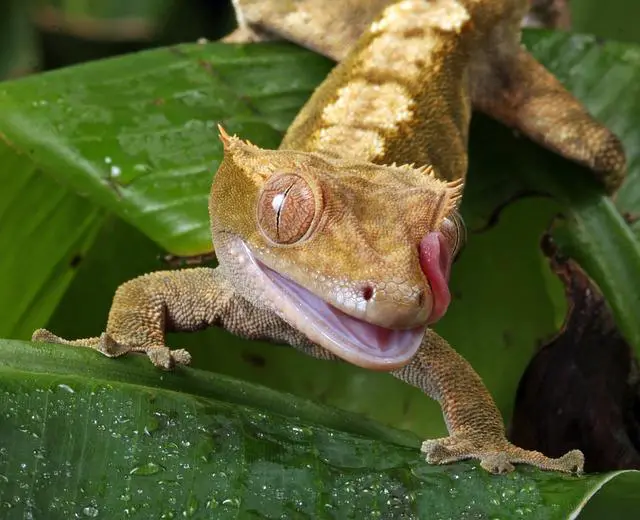Crested geckos are popular pets, and many people want to know if they can take their geckos outside. The answer is…it depends. In this blog post, we will discuss the pros and cons of taking your crested gecko outside, and help you decide if it’s the right decision for your pet.
How to take care of a crested gecko if you decide to let them outside
If you decide to let your crested gecko out of its cage, there are a few things you should do to make sure it stays safe.
First, crested geckos are good climbers, so be sure to create a safe space for them to roam by removing any sharp objects or potential escape routes.
Next, provide your crested gecko with plenty of places to hide, as they like to take cover when they feel threatened. You can do this by adding some plants or rocks to their enclosure.
Finally, keep an eye on your crested gecko and make sure it doesn’t get too cold or hot. If the temperature drops below 50 degrees Fahrenheit, be sure to bring your crested gecko inside.
By following these simple tips, you can help your crested gecko enjoy a safe and healthy life.
The risks of taking your crested gecko outside
If you’re thinking of taking your crested gecko outside for a little sunshine, you should be aware of the risks first.
One of the biggest dangers to your pet is predators.
Even in your own backyard, there could be any number of predators waiting to snatch up an easy meal. Birds of prey, cats, and even other reptiles can pose a threat to your gecko.
In addition, there are also a number of parasites that your pet could encounter outdoors. These include fleas, ticks, and mites, all of which can cause irritation and disease.
For these reasons, it’s generally best to keep your crested gecko indoors where he or she will be safe from harm.
What to do if your crested gecko gets sick or injured after being taken outside
If you take your crested gecko outside, it is important to keep a close eye on them to make sure they do not eat any poisonous plants or insects. In addition, you should be cautious of predators such as birds or snakes.
If your crested gecko does become sick or injured, the first thing you should do is take them to the vet. Reptile veterinarians are specially trained to deal with reptiles like crested geckos, and they will be able to provide the proper care and medication.
In addition, you should take steps to prevent your crested gecko from getting sick or injured in the future by providing a safe and clean habitat and keeping them away from potential dangers.
The benefits of keeping your crested gecko inside
When most people think of keeping a pet reptile, they envision a hot, humid terrarium filled with rocks and plants. However, reptiles can make great pets even for those who don’t want to deal with the hassle of setting up a complex habitat. Crested geckos are a perfect example of this.
These lizards are native to parts of southeast Asia, and they do best in warm, humid environments. However, they can also thrive in captivity if their housing is set up properly. Crested geckos are small lizards that only grow to about eight inches in length.
They are very docile creatures and make great pets for both children and adults. One of the main benefits of keeping your crested gecko inside is that you can control the environment.
You can provide your pet with the exact temperature and humidity levels that it needs in order to stay healthy. Another benefit is safety from predators. In the wild, these lizards fall prey to a variety of predators, but in captivity, they will be safe from harm.
Crested geckos are from New Caledonia – can they survive in other climates?
Crested geckos are a type of lizard that is native to the tropical island of New Caledonia. These lizards are well-adapted to their warm, humid environment and typically do not do well in other climates.
Crested geckos require a temperature of at least 70 degrees Fahrenheit and high humidity levels in order to thrive. In addition, they need access to hiding places and elevated surfaces where they can escape the heat of the sun.
If a crested gecko is kept in an environment that is too cold or too dry, it will become stressed and may become ill. As a result, it is important to research the care requirements of these lizards before bringing one home. While crested geckos can make interesting pets, they are not ideal for everyone.
Conclusion
Crested geckos are a type of Lizard that is indigenous to the Solomon Islands. In the wild, they are arboreal, which means they spend the majority of their time in trees. However, in recent years, they have become popular pets, and as a result, many people wonder if they can go outside.
The answer is yes, crested geckos can go outside, but there are a few things you need to keep in mind. First of all, crested geckos are tropical animals, so they need warm temperatures to thrive. If it is too cold outside, they will not be able to regulate their body temperature and may become sick.
In addition, crested geckos are very sensitive to light and UV rays, so you will need to provide them with plenty of shade if you take them outdoors.
Finally, crested geckos are escape artists, so you will need to make sure their enclosure is secure. With proper care and precautions, crested geckos can enjoy spending time outside in the sun and fresh air.




